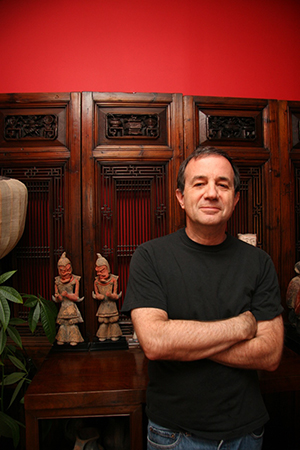|
|
|||
 |
About the Magazine | Advertising | Archives | Contact | ||
     |
|||
From facts to fiction
A sociologist-turned-fiction-writer finds inspiration in Southeast Asia.
An inquisitive Jew falls for an Asian woman, broadens his horizons, hones his writing with zeal and conviction—and plays the title role in Jeffrey Hantover’s historical epistolary novel, The Jewel Trader of Pegu (William Morrow). Published in January, the novel earned Hantover, AM’67, PhD’76, accolades as one of Barnes & Noble’s Discover Great New Writers and a Borders Original Voices author. Publishers Weekly applauded his “delicacy and grace” in braiding the stories of his improbable lovers, and the Seattle Post-Intelligencer declared the book “a brilliant gem.”

Jeffrey Hantover studied up on 16th-century Southeast Asia to write a historical-fiction novel.
The love story involves Abraham, a 16th-century Jewish merchant from Venice, and Mya, a timid bride from the Burmese kingdom of Pegu. There it was customary for foreign traders to deflower brides; torn between religion and local tradition, Abraham acquiesces, and then takes Mya in when her intended groom dies, igniting a fierce love that transcends cultural barriers
The intersection of cultures has long interested Hantover. Growing up Jewish in 1950s Kansas City, Missouri, his family was discouraged from living in certain neighborhoods. “As a minority,” he says, “you’re observing yourself in situations, more self-conscious about your behavior,” a quality he found useful in his sociology studies at Chicago.
Recruited to Vanderbilt University in 1975, he taught sociology for two years before becoming a social worker in New York City. In his spare time he explored Manhattan’s art scene—especially black-and-white photography—and eventually left social work to take a stab at becoming a critic. “I was hoping to translate my love of art into a career,” he says. “I had the foolish idea that I could make a living writing about it.”
In 1989 his wife, Mee-Seen Loong, accepted a job at Sotheby’s in Hong Kong. For his part, Hantover landed a gig as the arts and antiques columnist for a gossip rag, the Hong Kong Tattler. Besides a smattering of published articles on photography, he says, “I honestly think I was hired because I could write decent English, and people thought I knew something about art and antiques because my wife worked at Sotheby’s.” He reported on Asian art, food, and culture—plus special-exhibit collections in Hong Kong, such as Rodin sculptures and Dutch paintings.
The idea for Jewel Trader came to Hantover on a 1991 trip to Vietnam, where he was sent to collaborate on a contemporary-art show, Uncorked Soul. To bone up on the country’s history, he skimmed the text Southeast Asia in the Age of Commerce 1450–1680 (Yale University Press, 1990), in which historian Anthony Reid examined 15th-century European travelers’ impressions of “kingdoms and cities that are now only exotic names and backwaters.” He stopped cold at one sentence: “In Pegu…foreign traders were asked to initiate brides.” An entire book—and hero—crystallized around that salty bit.
Returning to New York with Loong and their daughter, Lixian Loong Hantover, AB’07, in 2001, Hantover hunkered down with a draft of Jewel Trader. “I’m no John Grisham,” he allows. “But the characters were so developed that it got to the point where if I didn’t finish the novel, they’d sort of die. I owed it to them.”
His Chicago education helped him slip into the milieu of 1598 Pegu, in modern-day Myanmar. “As a sociologist,” says Hantover, “I’m taught not to say, ‘How strange!’ but ‘How can I understand?’” He read traveler accounts of Southeast Asia and academic studies of the region, including an analysis of village life and Buddhist thought in Burma. To juxtapose Abraham’s old and new lives, he also researched Judaism in Renaissance Italy. Abraham’s letters to his cousin—which form the first-person narrative—reflect both on life in Venice and the action in Pegu.
Those letters show Abraham’s evolution from a guarded, judgmental Venetian to an enlightened global citizen. “When I first arrived, I judged [the Peguans] dull and thick-witted,” the character admits, “but hidden beneath…are quick minds and generous souls.” As Abraham falls in love with Mya, Hantover says, he finds it “harder to view the Burmese as the ‘other.’”
Hantover’s novel-in-progress, The Forenoon Bride, draws from a British ballad called “Lord Bateman” about “a love triangle that’s always intrigued me.” A 16th-century Jew again plays a pivotal role in this tale, which unfolds in England, Istanbul, and Rhodes. “In some of the versions [of the ballad], there is passing mention of the ‘forenoon bride,’” one of the players in the love triangle, says Hantover. “I was interested in giving her a voice and telling her story.”
Presenting multiple—sometimes competing—perspectives is a theme in Hantover’s work. “If fiction is too black and white, putting everything in neat little boxes,” he says, “it doesn’t leave any room for the reader to engage.”